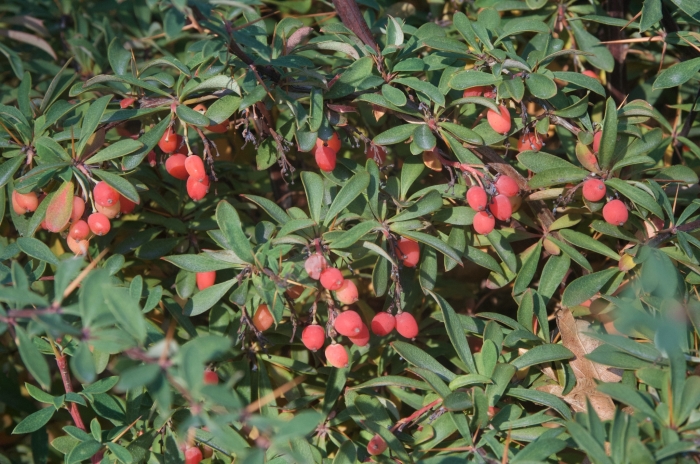Mrs. Wilson’s Barberry
(Berberis wilsoniae)
Mrs. Wilson’s Barberry (Berberis wilsoniae)
/
/

© Jon Sullivan
CC BY 4.0
Image By:
© Jon Sullivan
Recorded By:
Copyright:
CC BY 4.0
Copyright Notice:
Photo by: © Jon Sullivan | License Type: CC BY 4.0 | License URL: http://creativecommons.org/licenses/by/4.0/ | Uploader: jon_sullivan | Publisher: iNaturalist |


















Estimated Native Range
Summary
Berberis wilsoniae, commonly known as Mrs. Wilson’s Barberry, is a deciduous shrub native to the mountainous regions of Tibet, south-central China, and Myanmar, where it thrives in rocky soils and open woodlands. It is also found in New Zealand, where it has been introduced. This species typically grows to 3-6 feet in height and width, forming a dense, mound-like shape. The foliage of Mrs. Wilson’s Barberry is distinctive, with bluish-green leaves that turn a striking red in the autumn. In spring, it produces clusters of small, yellow flowers that are moderately showy and followed by attractive, translucent pink berries that persist into winter.
Mrs. Wilson’s Barberry is valued for its ornamental appeal, including its colorful autumn foliage and its fruit, which provides visual interest and can attract birds. It is also appreciated for its resilience and deer resistance, making it a suitable choice for urban planting, border planting, and as a hedge in areas with deer pressure. This shrub prefers full sun to part shade and requires well-drained soil. It is relatively low maintenance but may require occasional pruning to maintain its shape. While it is generally disease-resistant, it can be susceptible to rust and root rot if grown in poorly drained soils. Cultivars such as ’Nimbus’ and ’Pygmy’ offer variations in size and foliage color for gardeners seeking different aesthetic qualities.CC BY-SA 4.0
Mrs. Wilson’s Barberry is valued for its ornamental appeal, including its colorful autumn foliage and its fruit, which provides visual interest and can attract birds. It is also appreciated for its resilience and deer resistance, making it a suitable choice for urban planting, border planting, and as a hedge in areas with deer pressure. This shrub prefers full sun to part shade and requires well-drained soil. It is relatively low maintenance but may require occasional pruning to maintain its shape. While it is generally disease-resistant, it can be susceptible to rust and root rot if grown in poorly drained soils. Cultivars such as ’Nimbus’ and ’Pygmy’ offer variations in size and foliage color for gardeners seeking different aesthetic qualities.CC BY-SA 4.0
Plant Description
- Plant Type: Shrub
- Height: 3-4 feet
- Width: 4-6 feet
- Growth Rate: Moderate
- Flower Color: Yellow
- Flowering Season: Spring, Summer
- Leaf Retention: Semi-deciduous
Growth Requirements
- Sun: Full Sun, Part Shade
- Water: Low, Medium
- Drainage: Fast, Medium, Slow
Common Uses
Border Plant, Drought Tolerant, Hedges, Low Maintenance
Natural Habitat
Native to rocky soils and open woodlands in Tibet, south-central China, and Myanmar
Other Names
Common Names: Wilson’s Barberry, Barberry
Scientific Names: , Berberis wilsoniae, Berberis bodinieri, Berberis coryi, Berberis favosa, Berberis heteropsis, Berberis parvifolia, Berberis reticulinervis var. brevipedicellata, Berberis stapfiana, Berberis subcaulialata
GBIF Accepted Name: